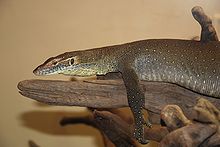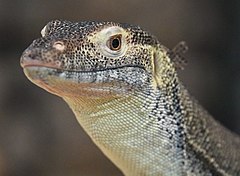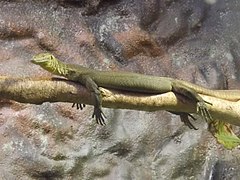Mertens' water monitor
| Mertens' water monitor | |
|---|---|

| |
| Smithsonian National Zoological Park | |
| Scientific classification | |
| Domain: | Eukaryota |
| Kingdom: | Animalia |
| Phylum: | Chordata |
| Class: | Reptilia |
| Order: | Squamata |
| Family: | Varanidae |
| Genus: | Varanus |
| Subgenus: | Varanus |
| Species: | V. mertensi
|
| Binomial name | |
| Varanus mertensi Glauert, 1951
| |
Mertens' water monitor (Varanus mertensi), often misspelled Mertin's water monitor, is a species of monitor lizard. The species is endemic to northern Australia, and is a wide-ranging, actively foraging, opportunistic predator of aquatic and riparian habitats.[2] It is named after German herpetologist Robert Mertens.[3]
Description[edit]
Mertens' water monitor grows to a total length (including tail) of about 2.0 m (6.6 ft). It is dark brown to black above, with many cream to yellow spots. The underparts are paler – white to yellowish – with grey mottling on the throat and blue-grey bars on the chest. The tail is strongly compressed laterally, with a high median dorsal keel, and is about 1.5 times the length of head and body.[4]
Amongst all monitor species, including the water monitors of Soterosaurus, Mertens' water monitor is morphologically the most well adapted to an aquatic lifestyle, being able to seal its upwards facing nostrils when underwater.[5] It is capable of swallowing prey underwater, which is an ability not reported in any other monitor species other than the Borneo earless monitor (Lanthanotus borneensis).[6]
Distribution and habitat[edit]
Mertens' water monitor is found in coastal and inland waters across much of northern Australia, from the Kimberley region of Western Australia, across the Top End of the Northern Territory and the Gulf Country, to the western side of the Cape York Peninsula in Far North Queensland.[4]
Behaviour[edit]
Mertens' water monitor is semiaquatic, a strong swimmer, and seldom far from water. It is often seen basking on midstream rocks and logs, and on branches overhanging swamps, lagoons, and waterways throughout its range. When disturbed, it drops into the water, where it can stay submerged for long periods.[4] It has been observed sleeping underwater.[5]
Feeding[edit]
Mertens' water monitor feeds both on land and in the water, mainly on fish, frogs, crabs, crayfish, shrimps, amphipods, and carrion, also taking terrestrial vertebrates, insects, spiders, and human rubbish when available.[4][7] It has a good sense of smell and may dig up prey when foraging, including the eggs of freshwater turtles.[8]
Breeding[edit]
Mertens' water monitor lays eggs in a burrow, usually with egg-laying taking place early in the dry season and hatching in the following wet season. The eggs hatch within 200–300 days after laying, depending on temperature, with the hatchlings able to enter the water and swim immediately.[8][9]
Conservation and status[edit]
Mertens’ water monitor is threatened by the spread of cane toads through its range, through poisoning after eating them. Because of this V. mertensi is listed as Vulnerable under Northern Territory legislation.[8]
Gallery[edit]
-
Portrait of Mertens' water monitor in the Northern Territory
-
Mertens' water monitor at the Grotto waterhole near Wyndham, Western Australia
References[edit]
- ^ Shea, G.; Woinarski, J.C.Z.; Macdonald, S.M.; Cogger, H. (2018). "Varanus mertensi". IUCN Red List of Threatened Species. 2018: e.T83778246A101752340. doi:10.2305/IUCN.UK.2018-1.RLTS.T83778246A101752340.en. Retrieved 19 November 2021.
- ^ Mayes, Phillip James (2006). The ecology and behaviour of Varanus mertensi (Reptilia: Varanidae) (Dissertation submitted for the Degree of Doctor of Philosophy). Perth, Western Australia: Faculty of Natural Sciences, Edith Cowan University.
- ^ Beolens, Bo; Watkins, Michael; Grayson, Michael (2011). The Eponym Dictionary of Reptiles. Baltimore: Johns Hopkins University Press. xiii + 296 pp. ISBN 978-1-4214-0135-5. (Varanus mertensi, p. 176).
- ^ a b c d Cogger HG (1979). Reptiles and Amphibians of Australia. Sydney: Reed. p. 257. ISBN 0-589-50108-9.
- ^ a b Auliya, Marc; Koch, André (2020). Visual Identification Guide for the Monitor Lizard Species of the World (Genus Varanus) (552 ed.). DE: Bundesamt für Naturschutz. doi:10.19217/skr552. ISBN 978-3-89624-290-7.
- ^ Mendyk, Robert; Shuter, Avishai; Kathriner, Andrew (2015). "Historical Notes on a Living Specimen of Lanthanotus borneensis (Squamata: Sauria: Lanthanotidae) Maintained at the Bronx Zoo from 1968 to 1976". BIAWAK. 9 (2): 44–49.
- ^ "Varanus Mertensi".
- ^ a b c "Threatened Species of the Northern Territory: Mertens Water Monitor" (PDF). Simon Ward, John Woinarski, Tony Griffiths and Lindley McKay (compilers). Department of Natural Resources, Environment and the Arts, Northern Territory. November 2006. Archived from the original (PDF) on 9 October 2009. Retrieved 10 January 2010.
- ^ OzAnimals.com: Mertens’ Water Monitor.








